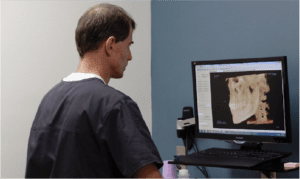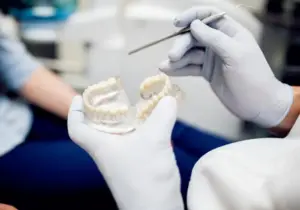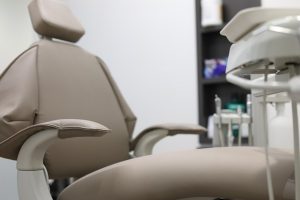Missing a tooth or facing a tooth extraction? You’re not alone. In fact, the average adult aged 35 to 49 in the United States is missing seven teeth. Even kids sometimes lose their adult teeth and end up needing full or partial dentures. Assuming maybe 4 of those “missing” teeth are due to a routine wisdom teeth extraction, that still leaves 3 teeth that are just missing, whether due to an accident, gum disease, or tooth decay.
Chances are there is someone you know who has had to replace missing teeth, though you might not be aware of it yourself. That’s because now many options for tooth replacement look like the natural tooth; you can’t tell from the person’s smile they ever lost a tooth. High-quality tooth replacements that look just like the real thing are becoming more commonplace. It’s come a long way from colonial times when replacements for missing teeth were a cobbled-together bunch of animal teeth, human teeth, ivory, and wooden pegs a la George Washington. These days, the only false teeth replacements that enter your mouth are made of metal and ceramic.
There are several great options for tooth replacement. But you know one terrible option? Doing nothing about it. Leaving an empty root space in your jaw can lead to all sorts of problems. Your surrounding teeth will shift, causing issues with your bite and perhaps even leading to further tooth loss. Finding tooth replacements done on the fly is in your best interest—we can’t overstate how important it is for your oral health that you have all of your sockets filled with teeth or titanium fake replacement teeth that look realistic. What happens to a toothless jawbone isn’t pretty.
Your jawbone also starts to literally disintegrate in that area. The longer you go without replacing a missing tooth, the harder it becomes to get permanent dental implants in the future, because to get permanent dental implants, you need a healthy jaw. So, if you’ve waited to do anything about replacing your missing tooth, you may require dental bone grafting, which is when we try to rebuild the jawbone using other bone material in your body. If your jawbone’s integrity is intact, you might even be eligible to get replacement teeth that are installed on the same day you come in. Seriously, it’s in your best interest to act fast. Otherwise, you’ll have a jawbone that’s falling apart, and you’ll have to spend months of time just to get one missing tooth replaced.
Here are 7 options for you to consider for tooth replacement. The right option depends on your budget, preferences and unique dental care needs.
1. Dental Implants
Dental implants are by far your best option for tooth replacement. That’s because dental implants look and function like natural teeth. They’re honestly some of the most realistic-looking replacements for missing teeth out there. The only real tell-tale sign is that titanium implants leave a dark ring around the gums in most cases. We surgically attach a dental implant post into your jawbone. This is topped with a ceramic crown that looks like a natural tooth; it’s even shaded to match the color of your other teeth. That’s what we mean by replacement teeth that look convincingly real—your dentist isn’t going to leave you with a mismatched tooth to contend with. It’s easy to make incredibly convincing replacement teeth with modern technology. The beauty of dental implants is they are a permanent solution to tooth replacement. Success rates for dental implants are 95%.
And yes, same day dental implants are possible — depending on the strength of your jawbone. Like we said, the longer you’ve gone without replacing the tooth, the more likely you’ll need a dental bone graft — which can make same day dental implants challenging. However, typically we’ll perform the initial dental implant surgery and then give the bone time to heal around the implanted “root” before attaching the crown. You can even get multiple replacement teeth done on the same day. It’s nothing short of a miracle for patients who are missing several teeth but still have a strong jawbone. This is a fantastic option for younger patients in good health who may have experienced facial trauma and lost multiple teeth at once.
There are two options for dental implants: titanium and zirconia. Titanium makes a great artificial root because the jawbone will grow around it and actually fuse to its surface. Titanium dental implants are the traditional and most common type of dental implant because they’re tried and true. A newer option is zirconia dental implants, which share many of the same properties as titanium, except they’re not metal. Zirconia is a ceramic, so it’s a great option for people who are allergic to metal.
Be aware that dental implants are expensive. They can cost thousands of dollars. Some insurance companies consider dental implants cosmetic and so may not cover the treatment.
2. Implant-Supported Bridges
Are you missing several teeth close together? Bridges supported by dental implants are a more affordable option than replacing each tooth with a dental implant. You receive a bridge that is held in place with dental implants on either side. This is a stronger, longer lasting option than dentures, but they aren’t designed to last forever. Eventually, they will need to be replaced. The reason this type of bridge isn’t completely permanent is because, while supported by dental implants at each end, the bridge itself sits on the gums. Since there is nothing rooted into your jaw in that area, other teeth may move and the jaw bone will degrade, as we discussed earlier.
Traditional bridges need healthy teeth on either side for support. Implant-supported bridges are an excellent option for missing teeth replacements when those surrounding teeth are damaged or decayed. They offer better stability than dentures too, allowing you to go about your daily life uninterrupted by your missing teeth. They can help individuals regain confidence eating and smiling in front of others.
3. Tooth Supported Bridge
As we mentioned, dental implants can get expensive. For a more affordable alternative, we can also introduce a bridge that is held in place with your existing teeth — no dental implants required. The teeth at either end of the area of missing teeth are ground down to fit the bridge correctly. Then, a crown is placed on those anchor teeth and cemented into place. You get the same natural look you’d have with a dental implant without the expense. Tooth-supported bridges are not a permanent tooth replacement, however, and will need to be adjusted and replaced overtime.
If you’re nervous about being operated on, this is a great way to replace missing teeth. It’s a non-invasive procedure, and it’s able to be finished up quickly. Keep in mind these tooth replacement options do rely on the support of healthy teeth to hold them up. If something goes awry with one of the support teeth, you’ll be looking at alternatives for tooth replacements for multiple teeth. The process of preparing the supporting teeth, which involves grinding them down, may also weaken and damage them.
4. Removable Partial Dentures
Removable partial dentures are a simple, affordable option to replace missing teeth. Rather than a full set of dentures, partial dentures are designed to replace a few missing teeth that are next to each other. The dentures are clasped into place so that the false teeth are positioned in the right spots. You’ll of course need to remove the dentures at night, soak them, and clean them — just as you would a full set of dentures.
When it comes to affordable replacement teeth options, removable partial dentures are both inexpensive and simple. If you have multiple teeth in a row that are missing and need replacements, partial dentures can be a great option. Partial removable dentures won’t stimulate your jawbone in the same way that implants or similar replacement teeth will, and they can lead to degradation of the bone over time.
5. Flipper
A flipper is a partial denture with the ability to flip in and out of its position, hence the name. It is not attached to surrounding teeth and is not clasped into place. It’s lighter than a partial denture and also cheap. It’s not a durable tooth replacement at all, and it’s not designed to be. A flipper is a temporary measure, something you can use until a more permanent option is available or you can afford it. It’s basically just a cheap replacement tooth that keeps things looking fine until an implant or something more permanent is constructed.
6. Removable Complete Dentures
If you are missing all of your teeth, you might consider getting a full set of dentures. A full mouth reconstruction can be way too expensive for some people, so this is a low-cost and non-invasive alternative to dental implant treatment. You can have the appearance of natural teeth and be able to eat normally again. Dentures are replacement teeth that look surprisingly real. It’s a great option for patients who are looking for a simple solution to their missing teeth. Dentures can almost immediately restore their ability to speak coherently and enjoy most foods again.
Dentures are affixed via suction or an adhesive, and should be removed daily to be cleaned and disinfected. They can also don’t stop your mouth from shifting since there is no dental implant filling the empty root cavities. As your mouth changes, the dentures might not fit as tightly. Eventually, they’ll need to be resized and replaced. Keep in mind that dentures don’t prevent the bone loss that occurs in the jawbone due to missing teeth. While they’re effective tooth replacements for a lot of people, they may not be the best option long-term and for the health of an otherwise normal jawbone.
7. Resin Bonded Bridge
Also known as a Maryland bridge or a Rochette bridge, a resin bonded bridge is designed to replace only the front teeth. That’s because it is fragile and cannot withstand the force of a full bite. A resin bonded bridge consists of two wings that are attached to the back of the abutment teeth on the tooth surfaces nearest to the tongue. The wings are attached to the replacement tooth or pontic.
You’ll need healthy and strong front teeth to support the new fake one. We may remove some tooth enamel to create a rougher surface for easier attachment.










